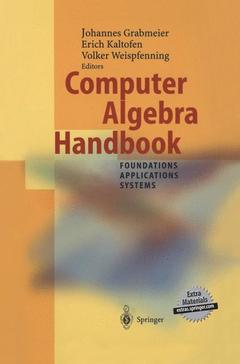Description
Computer Algebra Handbook, Softcover reprint of the original 1st ed. 2003
Foundations · Applications · Systems
Coordinators: Grabmeier Johannes, Kaltofen Erich, Weispfenning Volker
Language: English
Subjects for Computer Algebra Handbook:
Computer Algebra Handbook
Publication date: 10-2012
637 p. · 15.5x23.5 cm · Paperback
Publication date: 10-2012
637 p. · 15.5x23.5 cm · Paperback
Computer algebra handbook foundations, applications, systems @weitere uhb : translated by m hitz
Publication date: 11-2002
637 p. · Hardback
Publication date: 11-2002
637 p. · Hardback
Description
/li>Contents
/li>Comment
/li>
Two ideas lie gleaming on the jeweler's velvet. The first is the calculus, the sec ond, the algorithm. The calculus and the rich body of mathematical analysis to which it gave rise made modern science possible; but it has been the algorithm that has made possible the modern world. -David Berlinski, The Advent of the Algorithm First there was the concept of integers, then there were symbols for integers: I, II, III, 1111, fttt (what might be called a sticks and stones representation); I, II, III, IV, V (Roman numerals); 1, 2, 3, 4, 5 (Arabic numerals), etc. Then there were other concepts with symbols for them and algorithms (sometimes) for ma nipulating the new symbols. Then came collections of mathematical knowledge (tables of mathematical computations, theorems of general results). Soon after algorithms came devices that provided assistancefor carryingout computations. Then mathematical knowledge was organized and structured into several related concepts (and symbols): logic, algebra, analysis, topology, algebraic geometry, number theory, combinatorics, etc. This organization and abstraction lead to new algorithms and new fields like universal algebra. But always our symbol systems reflected and influenced our thinking, our concepts, and our algorithms.
1 Development, Characterization, Prospects.- 1.1 Historical Remarks.- 1.2 General Characterization.- 1.3 Impact on Education.- 1.4 Impact on Research.- 1.5 Computer Algebra — Today and Tomorrow.- 2 Topics of Computer Algebra.- 2.1 Exact Arithmetic.- 2.2 Algorithms for Polynomials and Power Series.- 2.3 Linear Algebra.- 2.4 Constructive Methods of Number Theory.- 2.5 Algorithms of Commutative Algebra and Algebraic Geometry.- 2.6 Algorithmic Aspects of the Theory of Algebras.- 2.7 Computational Group Theory.- 2.8 Algorithms of Representation Theory.- 2.9 Algebraic Methods for Constructing Discrete Structures.- 2.10 Summation and Integration.- 2.11 Symbohc Methods for DiflFerential Equations.- 2.12 Symbolic/Numeric Methods.- 2.13 Algebraic Complexity Theory.- 2.14 Coding Theory and Cryptography.- 2.15 Algorithmic Methods inUniversal Algebra and Logic.- 2.16 Knowledge Representation and Abstract Data Types.- 2.17 On the Design of Computer Algebra Systems.- 2.18 Parahel Computer Algebra Systems.- 2.19 Interfaces and Standardization.- 2.20 Hardware Implementation of Computer Algebra Algorithms.- 3 Applications of Computer Algebra.- 3.1 Physics.- 3.2 Mathematics.- 3.3 Computer Science.- 3.4 Engineering.- 3.5 Chemistry.- 3.6 Computer Algebra in Education.- 4 Computer Algebra Systems.- 4.1 General Purpose Systems.- 4.2 Special Purpose Systems.- 4.3 Packages.- 5 Meetings and Publications.- 5.1 Conferences and Proceedings.- 5.2 Books on Computer Algebra.- Cited References.- Index for Authors’ Contributions.
Most comprehensive overview on computer algebra systems and related topics Includes supplementary material: sn.pub/extras
© 2024 LAVOISIER S.A.S.




